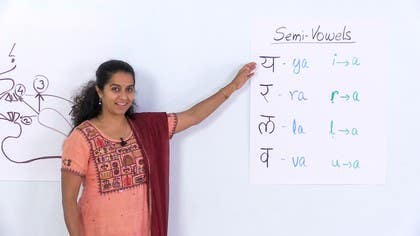Description
About This Video
Transcript
Read Full Transcript
Namaste, my Sanskrit Yoga family. You're doing a great job. We've gone through the consonants together. There were 25 of them. We started with the vowels first and we saw that there were five vowels, primary vowels, corresponding to the five places of pronunciation. We had the a, i, u, r, and r, a, i, u, r, and r. Then we saw the consonants and we saw that there are five letters that correspond to each of these places of pronunciation. What is remarkable about the organization of these letters is that it follows the way in which sound comes out of the human vocal system. There is, in a sense, a complete massage of your vocal system using these consonants and accompanying that with your breath. So it's a pranayama, it's a massage, all just with the language. So we next will have a look at the semi vowels. When we were looking at the vowels, we had gone from a to e, and we got a sound in the middle, the a. I'll give you a demo. It's like aaayyyyyyyy. You got the a in the middle. Now let's reverse it. Go from e to a really fast and see what it gives you. Try it. E to a fast that's it yeah yeah so that's our first semi vowel yeah yeah so we are at this point and we do an e to an a yeah this part of the touch corresponds or the cerebral vowel corresponds to the let's do the same thing go from the to the and see what it gives you try it first to yes it's the the third one is the one corresponding to the dentals from the to the go from the to the and see what you get lovely the final one is when you try to go from the to the right you would have probably said what which is not wrong but in Sanskrit this letter has been defined as a tooth and lip sound it's the like in English you have the sound V for victory and you have the W which is like the when or where in Sanskrit both these sounds exist depending on where they are used but normally when they form part of the Sanskrit semi vowel system they would be pronounced it would be pronounced as the V so we have yeah e to a yeah to a yeah we'll do that one school yeah did you notice what is really remarkable about the combination of the consonants with the semi vowels is that as you pronounce the consonants you follow the order in which sound comes out of the vocal system and now you are sort of reversing that order back and doing a remissage in the reverse order okay now as we have been seeing with our different consonants we know what they sound like now let's try and get an idea of what they look like so we'll see the semi vowels now the first semi vowel that we had seen was the yeah this is the Devanagari representation of the letter the sounds of the Sanskrit language can be represented by various scripts but the most popular script used to represent these sounds or the Sanskrit language is the Devanagari script in the Devanagari script the year looks like this and you can also probably recognize the similarity with the Roman script in that it's a bit like the year a little bit now we have an equivalent in the Roman alphabet for the sound which is known as the transliteration of these sounds it is the yeah okay it's the phonetic representation in the Roman alphabet and in terms of the touch sound it corresponds to going from the vowel e to a yeah the next letter is the one going from your from the cerebrals to this to your throat it's the and this is what it looks like in transliteration it's quite simple it's the R and A and we arrive at this by going from the the to the A the letter R to the A that's the want to try saying that lovely the next one is from the teeth to the throat the vowel to a let's see what it looks like every time I see it I remember the McDonald's and loving it and you will remember that letter okay so in transliteration it is the L and the A the L and it's represented by the going towards the the final semi vowel that we have the fourth one is when you try and go from the oo to the the V it's a little off the teeth on the lips a verb it's quite a strong sound it looks like that and if you remember the lesson we had done for the labials we had the letter bur which was like the baby the mother's tummy this one is the same but without the line in the middle and what is again very interesting to notice is that there is often a confusion between these two letters in various languages where people would write a V and pronounce it as a B as in Spanish you write a V but it's pronounced as Ben Tana or for example in Bengali in one of the regional Indian languages they would write the Vedas but pronounce it as the bathers so it's interesting that there is this confusion between the two sounds but the semi vowel is pronounced as the verb and in English transliteration it is the V and the A which corresponds to the fact of going from the oo to the a so there we are we'll try and do the semi vowels together yeah yeah once more yeah yeah you want to try saying that by yourself we're getting it we'll do together yeah there we've got the semi vowels also in place now and we're almost done we just have the last group of letters called the sibilants that we need to look at together and then we look at a few conjunct consonants which are combinations of sounds but for now practice this and I'm sure you'll do very well
Mother Tongue: Sounding and Seeing the Consonants
Comments
You need to be a subscriber to post a comment.
Please Log In or Create an Account to start your free trial.










